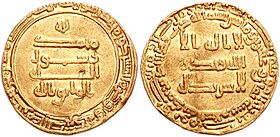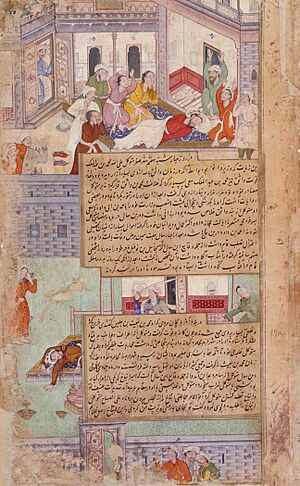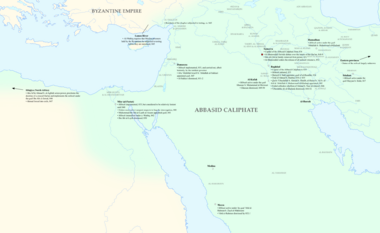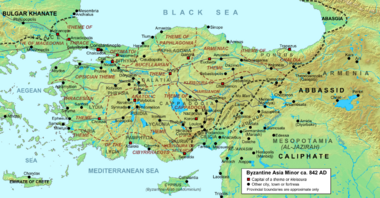- This page was last modified on 17 October 2025, at 10:18. Suggest an edit.
al-Wathiq facts for kids
| al-Wathiq الواثق |
|
|---|---|
|
|

Gold dinar of al-Wathiq, minted in Baghdad in 843
|
|
| 9th Caliph of the Abbasid Caliphate | |
| Reign | 5 January 842 – 10 August 847 |
| Predecessor | al-Mu'tasim |
| Successor | al-Mutawakkil |
| Born | 17 April 812 Near Mecca, Abbasid Caliphate |
| Died | 10 August 847 (aged 35) Samarra, Abbasid Caliphate |
| Burial | Samarra |
| Consorts | Qurb Farida Qalam |
| Issue | Muhammad al-Muhtadi |
| Dynasty | Abbasid |
| Father | al-Mu'tasim |
| Mother | Qaratis |
| Religion | Islam (Mu'tazilism) |
Abu Ja'far Harun ibn Muhammad (Arabic: أبو جعفر هارون بن محمد, romanized: Abū Jaʿfar Hārūn ibn Muḥammad; 17 April 812 – 10 August 847), known as al-Wathiq bi'Ilah (Arabic: الواثق بالله, romanized: al-Wāthiq biʾllāh, lit. 'He who trusts in God'), was an Abbasid caliph. He ruled from 842 until his death in 847.
Al-Wathiq was known for being well-educated and curious. He enjoyed poetry, music, and spending time with scholars. His short rule continued the policies of his father, al-Mu'tasim. The same important officials who served his father stayed in power. During his reign, there were some rebellions in places like Syria and Armenia. There was also a failed uprising in Baghdad in 846. This uprising was linked to al-Wathiq's strong support for a religious idea called Mu'tazilism. He also continued a special inquiry, called the mihna, to check people's religious beliefs. In foreign affairs, the fight with the Byzantine Empire continued. The Abbasids even won a big battle at Mauropotamos. After a prisoner exchange in 845, the fighting stopped for a few years.
Al-Wathiq's personality is not as well known as other early Abbasid caliphs. He seemed to enjoy court life and was a talented poet. He also supported other poets and musicians. He was interested in learning and scholarly topics. Al-Wathiq's sudden death meant there was no clear successor. His son, al-Muhtadi, was too young to rule. So, a group of leading officials chose his half-brother, al-Mutawakkil, to be the next caliph.
Contents
Early Life of Al-Wathiq
Al-Wathiq was born on April 17, 812, near Mecca. His father was al-Mu'tasim, who later became a caliph. His mother was Qaratis, a Byzantine Greek woman. He was named Harun after his grandfather, Caliph Harun al-Rashid.
Not much is known about al-Wathiq's early life. His father was a younger prince and not expected to become caliph. His father became powerful because he controlled a special army of Turkic soldiers. Al-Wathiq's first teacher was Harun ibn Ziyad. He learned writing, reading, and literature from his uncle, Caliph al-Ma'mun. Later, people called him "Little Ma'mun" because he was so smart and had good morals.
When al-Mu'tasim became caliph, he made sure al-Wathiq gained experience in ruling. In 835, al-Wathiq was left in charge of the capital, Baghdad. This was when his father moved north to build a new capital at Samarra. Al-Wathiq also welcomed the general al-Afshin after he won a battle in 838. He was also left as his father's deputy during the Amorion campaign that same year.
These events show that al-Wathiq was a trusted helper for his father. This prepared him well to take over as caliph. However, unlike earlier Abbasid princes, al-Wathiq never led an army. He did not even take part in the Amorion campaign.
Al-Wathiq's Reign as Caliph
Al-Wathiq was of medium height, handsome, and well-built. He had fair skin and a reddish face. His left eye was partly paralyzed, which made his gaze look stern. When his father, al-Mu'tasim, died on January 5, 842, al-Wathiq became caliph without any problems. He inherited a full treasury. The new caliph gave generous gifts to the people, especially in Baghdad and the holy cities of Mecca and Medina.
In 842, al-Wathiq sent his mother, Qaratis, and his brother Ja'far (who would become caliph al-Mutawakkil) on the hajj (pilgrimage). Qaratis died on the way and was buried in Kufa.
Key Officials and Power
Al-Wathiq's rule was short and continued his father's policies. The government was still led by the same powerful men. These included the Turkic military commanders Itakh, Wasif, and Ashinas. Also important were the vizier, Muhammad ibn al-Zayyat, and the chief judge, Ahmad ibn Abi Duwad. These men were loyal to al-Mu'tasim. But they were not as strongly tied to al-Wathiq. This meant that this small group of officials had a lot of control over the caliph's power.
To strengthen his ties with his most powerful commander, al-Wathiq gave a special crown to Ashinas in 843. He also gave Ashinas great power over the western provinces, from Samarra to the Maghreb. This was a very important step, as it was one of the first times a caliph gave so much royal power to someone else. Ashinas died in 844. Itakh then took over his role as commander-in-chief and governor of the western provinces.
The new caliph also built many new structures in Samarra. This helped turn the caliph's home into a proper city with markets and a port. This made Samarra more comfortable and a good place to invest in property. This was important for the Abbasid leaders and the army, who had been forced to move there by al-Mu'tasim.
However, in 843 or 844, the Caliph arrested and fined several government secretaries. This was done to raise money to pay the Turkic troops. This action might have been meant to create a divide between civilian and military leaders. It might also have been to reduce the power of top Turkic commanders like Itakh and Ashinas.
Putting Down Rebellions

The Abbasid Caliphate and its provinces around 850 AD
Before al-Mu'tasim died, a large revolt started in Palestine led by al-Mubarqa. Al-Mu'tasim sent general Raja ibn Ayyub al-Hidari to stop it. When al-Wathiq became caliph, he sent al-Hidari against Ibn Bayhas. Ibn Bayhas was leading a tribal revolt near Damascus. Al-Hidari quickly defeated Ibn Bayhas. Then he moved south and defeated al-Mubarqa's forces near Ramla. Al-Mubarqa was captured and imprisoned.
Al-Wathiq appointed Khalid ibn Yazid al-Shaybani as governor of Armenia. Khalid led a large army and defeated local Muslim and Christian leaders. Khalid died soon after, but his son, Muhammad ibn Khalid al-Shaybani, continued his father's work.
In spring 845, another tribal rebellion started. The Banu Sulaym tribe fought with other tribes near Medina. This led to bloody clashes. The local governor sent an army, but the Sulaym won. They then looted areas around the holy cities. In May, al-Wathiq sent his Turkic general, Bugha al-Kabir, to handle the situation. Bugha defeated the Sulaym and made them surrender. He also forced the Banu Hilal to submit. Bugha's troops took many prisoners. Bugha also used this chance to show his power to other tribes. He marched against the Banu Fazara and the Banu Murra. Many tribes submitted, while others fled. Bugha then brought back over 1,300 prisoners from the Banu Kilab to Medina in May 846.
A small uprising by the Kharijite group happened in 845/6. It was easily stopped by the governor of Mosul. In the same year, general Wasif stopped rebellious Kurdish tribes in Isfahan, Jibal, and Fars.
In September 846, al-Wathiq sent Bugha al-Kabir to stop the Banu Numayr tribe in Yamamah. On February 4, 847, Bugha fought a big battle against about 3,000 Numayris. At first, Bugha's forces struggled. But then, some of his troops returned and attacked the Numayris, defeating them completely. Bugha spent a few months bringing peace to the region. He offered safety to those who surrendered and chased those who did not. He returned to Basra in June/July 847, bringing over 2,200 captured Bedouin with him.
Mu'tazilism and a Failed Plot
Like his father, al-Wathiq strongly supported Mu'tazilism. This was a religious idea that believed the Quran was "created" by God, not eternal. This meant that the caliph, guided by God, could interpret the Quran for changing times. The chief judge, Ibn Abi Duwad, greatly influenced al-Wathiq. Al-Wathiq also kept good relations with the Alids, who were descendants of the Prophet Muhammad.
In the third year of his rule, al-Wathiq restarted a special inquiry called the mihna. Officials were sent to question religious scholars about their views on the Quran. Even during a prisoner exchange with the Byzantine Empire in 845, Muslim prisoners were questioned. Those who did not give the "correct" answers were reportedly left in captivity. Because of this, Ahmad ibn Hanbal, a famous scholar who disagreed with the Mu'tazili idea, had to stop his teachings. He only started again after al-Wathiq's death.
In 846, a respected leader named Ahmad ibn Nasr ibn Malik al-Khuza'i planned to overthrow al-Wathiq. He also wanted to get rid of the Turkic commanders and the Mu'tazilite ideas. His followers gave money to people. The uprising was planned for the night of April 4/5, 846. However, the signal to start was given a day early, and nothing happened. Another report says an informer told the authorities about the plot. Al-Khuza'i and his followers were arrested and brought before al-Wathiq in Samarra.
The Caliph questioned al-Khuza'i publicly, focusing on the religious question of the Quran's creation. Ahmad's answers made al-Wathiq so angry that the Caliph himself helped execute Ahmad with a famous sword. Twenty of Ahmad's followers were imprisoned.
In the same year, there was a break-in at the public treasury in Samarra. Thieves stole a large amount of silver and some gold. The chief of security caught them. This event might have shown that security was weak even at the main palace. It also suggested the treasury might have been almost empty.
Battles with the Byzantine Empire
In 838, al-Mu'tasim had won a big victory against the Byzantine Empire by capturing Amorion. After this, the fighting went back to smaller raids along the border. Byzantine sources say that when al-Mu'tasim died in 842, he was planning another big invasion. But his large fleet, meant to attack Constantinople, was destroyed in a storm. Muslim sources do not mention this event.
After al-Mu'tasim's death, the Byzantine leader Theoktistos tried to take back the Emirate of Crete. This was a state that paid tribute to the Abbasids. But his campaign failed badly. In 844, an army from the border regions raided deep into Byzantine Asia Minor. They reached the Bosporus strait. The Muslims then defeated Theoktistos at the Battle of Mauropotamos. This was helped by some Byzantine officers who switched sides. Around the same time, the Paulicians, a religious group persecuted in Byzantium, joined the Arabs. They formed a small state on the border and helped the Arabs attack Byzantine land.
In 845, Byzantine messengers came to the caliph's court to arrange a prisoner exchange. It happened in September of that year. Between 3,500 and 4,600 Muslim prisoners were set free. However, in March of the same year, 42 officers captured at Amorion were executed in Samarra. They refused to convert to Islam. After the prisoner exchange truce ended, the Abbasid governor of Tarsus led a winter raid. It failed terribly, with many men dying from cold or drowning, and 200 taken prisoner. After this, the Arab-Byzantine border was quiet for six years.
Only in the west did the Abbasids' allies, the Aghlabids, continue their slow conquest of Byzantine Sicily. They captured Messina (842/43), Modica (845), and Leontini (846). In 845/46, the Aghlabids captured Miseno near Naples in Italy. The next year, their ships appeared in the Tiber River and their crews raided the areas around Rome.
Death and Succession

Death of Caliph al-Wathiq, Mughal miniature from the Tarikh-I Alfi (1594)
Al-Wathiq died on August 10, 847, from a swelling illness, possibly due to liver problems or diabetes. He was trying to cure himself by sitting in an oven. He was buried in the Haruni Palace in Samarra, which he had built.
His death was unexpected. This meant there was no clear successor. The leading officials, including the vizier, Ibn al-Zayyat, and the chief judge, Ahmad ibn Abi Duwad, met to choose the next caliph. Ibn al-Zayyat first suggested al-Wathiq's son Muhammad (the future caliph al-Muhtadi). But because he was so young, they chose al-Wathiq's 26-year-old half-brother Ja'far. He became the caliph al-Mutawakkil.
Historians often see this choice as a plan to put a weak ruler on the throne. The same group of officials wanted to keep running things as they did under al-Wathiq. However, they were quickly proven wrong. Al-Mutawakkil soon removed Ibn al-Zayyat and Itakh and took full control.
Al-Wathiq's Character and Impact
Al-Wathiq was known for being kind to the poor in Mecca and Medina. He also lowered taxes on trade by sea. However, he does not seem to have been very popular. He was a talented poet, and more of his poems exist than any other Abbasid caliph. He was also a skilled composer and could play the oud well. He supported poets, singers, and musicians, inviting them to his palace. He especially favored the musician Ishaq al-Mawsili and the singer Mukhariq.
The historian al-Mas'udi described al-Wathiq as being "interested in scientific learning." He encouraged discussions among doctors. The movement to translate Greek texts into Arabic continued to thrive under his rule. Sources also show al-Wathiq's "intellectual curiosity." For example, he reportedly dreamed that the "Barrier of Dhu'l-Qarnayn" had been broken. This might have been due to news of Turkic tribes moving in Central Asia. He sent an official to travel to the region and investigate. Also, according to Ibn Khordadbeh, the Caliph sent the astronomer al-Khwarizmi to the Byzantines to look into the story of the Seven Sleepers of Ephesus.
Al-Wathiq is one of the less known Abbasid caliphs. Historian Hugh N. Kennedy said that "no other caliph of the period has left so little trace of the history of his times." It is hard to get a clear idea of his personality. The Encyclopaedia of Islam states that "he had not the gifts of a great ruler, and his brief reign was not distinguished by remarkable events." Because he is not very well known, William Beckford was able to create a very different version of al-Wathiq in his 18th-century novel Vathek. This book tells a fantasy story of cruelty and a search for lost treasure.
Family Life
One of al-Wathiq's partners was Qurb, a Greek woman. In 833, she gave birth to his son, Muhammad, who later became caliph al-Muhtadi. Another partner was Farida, who was also a musician and al-Wathiq's favorite. After al-Wathiq died, she became one of Caliph al-Mutawakkil's favorites. He had another partner who was a servant of Farida. Al-Wathiq was very fond of her. Another partner was Qalam. She was trained as a singer. Al-Wathiq bought her for a large sum of money and called her Ightibat, meaning "delight."
See Also
- List of Abbasid caliphs
- Abbasid Caliphate
Images for kids
|
Al-Wathiq
Born: 812 Died: 847 |
||
| Sunni Islam titles | ||
|---|---|---|
| Preceded by Al-Mu'tasim |
Caliph of the Abbasid Caliphate 5 January 842 – 10 August 847 |
Succeeded by Al-Mutawakkil |







